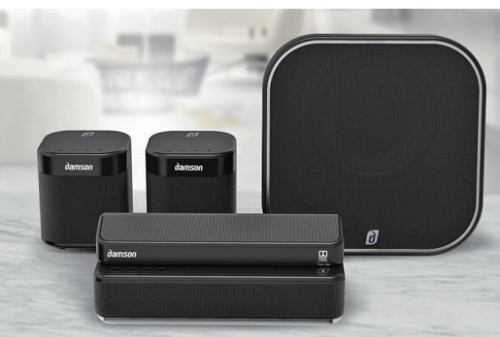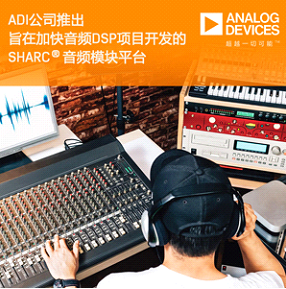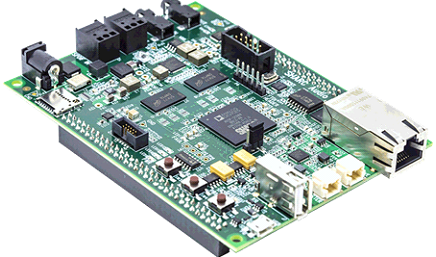|
The OP
Published on 2019-8-10 11:02
Only look at the author
This post is from DSP and ARM Processors
| ||
|
|
||
- 【Posts】Modular audio DSP solutions accelerate the development of high-end audio systems
- 【Posts】Domestic DSP teaching experiment box_Operation tutorial: 3-1 Audio acquisition and playback experiment
- 【Posts】Embedded DSP Teaching Experiment Box_Digital Signal Processing Tutorial: 3-5 AAC Audio Coding Experiment
- 【Posts】I want a dsp audio tuning software. If there is a project that can be developed, you can take a look.
- 【Posts】Let's talk about DSP audio processing
- 【Posts】FPGA+MCU low-cost solution for audio processing
- 【Posts】I want a dsp audio tuning software. If there is a project that can be developed, you can take a look.
- 【Posts】Embedded DSP Teaching Experiment Box_Digital Signal Processing Tutorial: 3-5 AAC Audio Coding Experiment
- 【Download】Fixed-point DSP implementation of HDTV audio decoding
- 【Download】High-performance digital MEMS microphones and standard digital audio interfaces to Blackfin DSP
- 【Download】Fixed-point DSP implementation of HDTV audio decoding.rar
- 【Download】DSP6748 audio processing algorithm
- 【Download】Design and Implementation of Audio Signal Generator Based on DSP
- 【Download】Application of DSP in digital signal processing and audio
- 【Download】\"Application of TI DSP in Audio Processing\" Program Code_TN068310
- 【Download】DSP realizes real-time processing system of dual-channel audio signals
- 【Design】E8300-001-GEVB: Ezairo 8300: High-End Audio DSP for Wireless Hearing Aids and Hearables
- 【Design】PICO DSP: an open source, Arduino-compatible, ESP32-based audio development board
- 【Design】Moyinshi HIFI high-end audio filter card
- 【Design】AVAS solution based on SPC582B60E1 Chorus series MCU and FDA903D Class D audio amplifier
- 【Articles】Acceleration Method for MPEG Audio Layer III Compression Using DSP
- 【Articles】ACM8629 mono 100W/stereo 50W built-in DSP audio algorithm I2S digital input Class D power amplifier IC solution
- 【Articles】ACM8629 Mono 100W/Stereo 50W Built-in DSP Audio Algorithm I2S Digital Input Class D Amplifier IC Solution
- 【Articles】DSP-based mixed-signal solutions solve advanced audio processing challenges
- 【Articles】Discrete high-fidelity audio solutions for high-end system requirements
- 【Articles】Analysis of CS485xx Digital Audio DSP Processing Solution
-
Award: Prize-winning quiz: Audio signal solution based on A2B
Prize-winningquiz:AudiosignalsolutionbasedonA2BPleaseseethelistbelowfordetailsTheawardconfirmationprocessconsistsof2steps:Step1:ScantheQRcodebelowtoreceivetheprizeviaWeChat,follow"ElectronicEngineeringWorldWelfareClub",andreceiveapop-upmess ...
-
Prize-winning quiz: Audio signal solution based on A2B
A2Bisasingle-master,multi-slaveaudiobussystemthatwasoriginallydesignedtosolveaudiodistributionchallengesinautomotiveapplicationsADIdevelopedtheA2BbusarchitecturetoaddresstheaboveissuesInthisvideo,wewillworkwithseniorengineerAllentoappreciat ...
-
Understanding the boost small signal model
Helloeveryone!I'mlearningaboutBoostsmallsignalmodelingrecentlyCouldyoupleasehelpexplainthemeaningofthefollowingsmallsignalmodel?Thankyou!
- Which of these five books do you want to be online first? Come and vote for it~
- Allwinner T113 dual-core heterogeneous processor based on Tina Linux5.0 - RTOS system custom development
- I would like some advice on how to import .brd files into DXP
- 【BLE 5.3 wireless MCU CH582】12. MounRiver IDE usage record
- LC High Pass Filter
- My humble opinion on the development of power supply enterprises in the 21st century
- [RT-Thread reading notes] Part 2: Implementing multithreading
EEWorld Datasheet Technical Support
-
Europe's three largest chip giants re-examine their supply chains
At the Electronica 2024 CEO Roundtable held just last week, the CEOs of three chip giants, Infine
-
It is reported that Kioxia will be approved for listing as early as tomorrow, and its market value is expected to reach 750 billion yen
On November 21, Reuters reported that with the support of Bain Capital, Kioxia will obtain approv
-
The US government finalizes a $1.5 billion CHIPS Act subsidy to GlobalFoundries to support the latter's expansion of production capacity in the US
On November 21, the U.S. Department of Commerce officially announced yesterday that it will provi
- SK Hynix announces mass production of the world's highest 321-layer 1Tb TLC 4D NAND flash memory, plans to ship it in the first half of 2025
- UWB is a new way to use it in cars. Can wireless BMS also use it?
- Filling the domestic gap! China Mobile, Huawei and others jointly released the first GSE DPU chip
- Samsung Electronics NRD-K Semiconductor R&D Complex to import ASML High NA EUV lithography equipment
- Apple reveals the secret of its own chip success: competitors can't use the latest cutting-edge technology
- A big chip war is about to start: Qualcomm and MediaTek are involved in notebooks, and AMD is reported to enter the mobile phone market
- Exynos 2600 chip is the key, Samsung is reportedly going to launch a 2nm chip counterattack
- Problems with STM32 and passive buzzer playing sound
- Embedded Tutorial_DSP Technology_DSP Experiment Box Operation Tutorial: 2-28 Building a Lightweight WEB Server Experiment
- OPA847IDBVR op amp domestic replacement
- AG32VF407 Test UART
- [Digi-Key Follow Me Issue 2] Chapter 1: Sharing on receiving the goods
- What model is this infrared receiver? Which model can be used instead? Thank you
- Selling brand new unopened ZYNQ 7Z020 FPGA core board
- The LORA module used in the lithium battery-powered water meter setting can save energy when 100 water meters are installed in one corridor.
- I would like to ask, when a port is set to RX0, is it necessary to set the input and output direction of this port?
- Why is this year so difficult? It’s even more difficult than during the pandemic. I’m 30 and facing unemployment. I’m so confused.
- Ask about the voltage regulator test question
- [Xiaohua HC32F448 Review] About Xiaohua Semiconductor's UART interrupt sending and PRINTF construction and redirection
- 【BIGTREETECH PI development board】 HDMI output test
- 【BIGTREETECH PI development board】+08. Audio test (zmj)
- [Xiaohua HC32F448 Review] +RTC electronic clock
- 有奖直播报名| 高可靠性IGBT新选择 —— 安世半导体650V IGBT
- 【直播时间】12月19日(周四)下午15:00-16:30
【直播好礼】定制双肩商务包、30元京东卡、吸管玻璃杯
- 安世半导体直播报名中
- 直播主题:安世半导体理想二极管与负载开关,保障物联网应用的稳健高效运行
直播时间:12月17日(周二)下午14:00
报名就有机会获得:定制双肩商务包、30元京东卡、吸管玻璃杯
- PI 电源小课堂 | 无 DC-DC 变换实现多路高精度输出反激电源
- 时间:即日起-12月15日
看视频学习电源干货,答题赢取京东卡!
- 参会有好礼 | 2024 瑞萨电子MCU/MPU工业技术研讨会
- 深圳站:11月30日(周六)深圳湾万怡酒店
上海站:12月06日(周五)上海喜玛拉雅酒店
奖励设置:现金红包、螺丝刀套装或30元京东卡
- Littelfuse 新品赋能电子产品安全可靠并高效, 10+挑战等你探索!
- Littelfuse 应用赋能星球,覆盖了诸多应用痛点及解决办法,邀请工程师一起探索,解锁更多设计力!
- 下载资料赢好礼!看Vicor模块化电源解决方案如何推动创新
- 活动时间:即日起-2024年12月31日
如何参与:点击活动页内您想了解的模块,找到资料下载即可参与抽奖,活动结束后统一发奖!
- 有奖活动|英飞凌高密度双相电源模块为高性能运算平台而生
- 活动时间:即日起-12月15日
活动奖励:蓝牙音箱、氮化镓充电器套装、黑色小背包
- 本周精选下载推荐:电源管理基础Dummies
- 本周小编给大家带来一本超简单、超干货的电子书——《电源管理基础Dummies》!内容深入浅出,排版舒服简洁,分分钟能get到电源管理最核心的知识内容。
EEWorld
subscription
account

EEWorld
service
account

Automotive
development
circle

About Us Customer Service Contact Information Datasheet Sitemap LatestNews
- I want to get started with 3D machine vision, what should I do?
- I want to get started with CNN convolutional neural networks, what should I do?
- For Octave machine learning introduction, please give a learning outline
- For an introduction to neural network programming, please give a study outline
- For elementary school students who are just starting to learn microcontrollers, please give a learning outline
- How long does it take to get started with FPGA?
- What is the best thing to do with an entry-level FPGA?
- How to buy an entry-level microcontroller
- How to get started with neural networks
- How to get started with microcontroller learning


 Room 1530, Zhongguancun MOOC Times Building,
Block B, 18 Zhongguancun Street, Haidian District,
Beijing 100190, China
Tel:(010)82350740
Postcode:100190
Room 1530, Zhongguancun MOOC Times Building,
Block B, 18 Zhongguancun Street, Haidian District,
Beijing 100190, China
Tel:(010)82350740
Postcode:100190
 京公网安备 11010802033920号
京公网安备 11010802033920号





 提升卡
提升卡 变色卡
变色卡 千斤顶
千斤顶